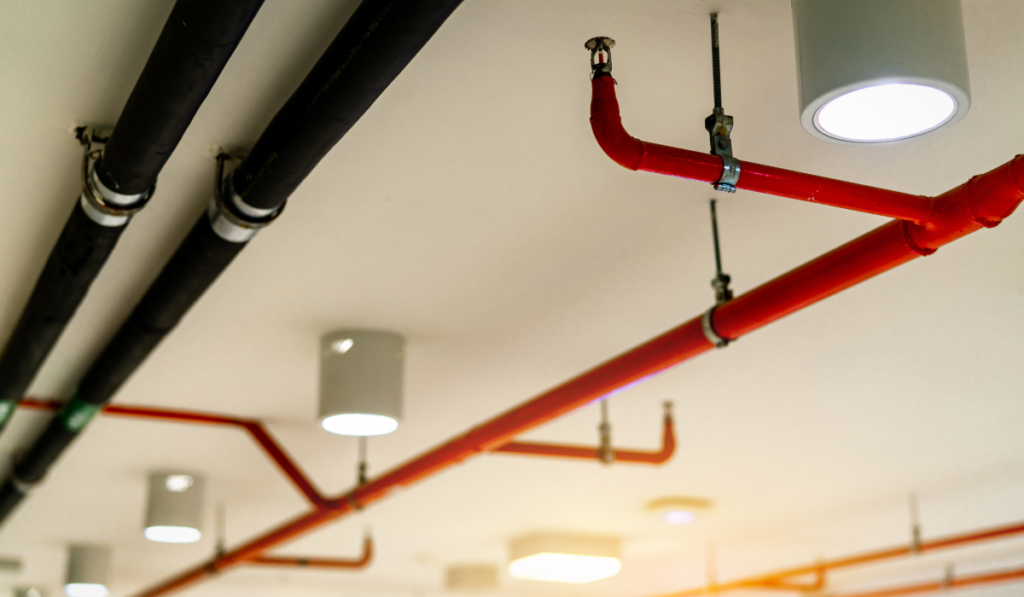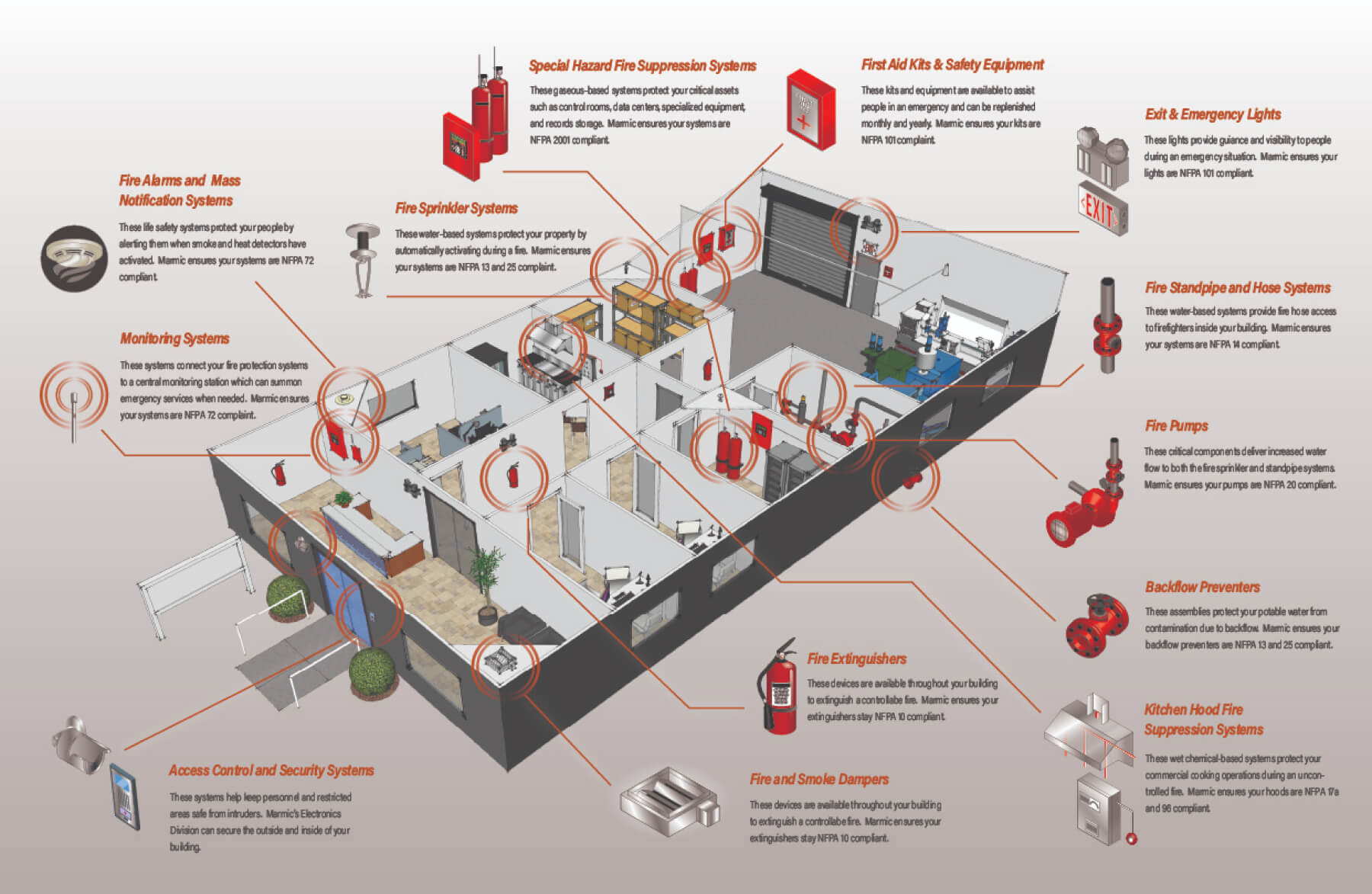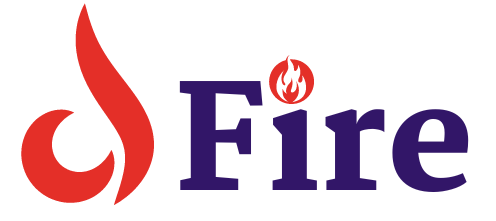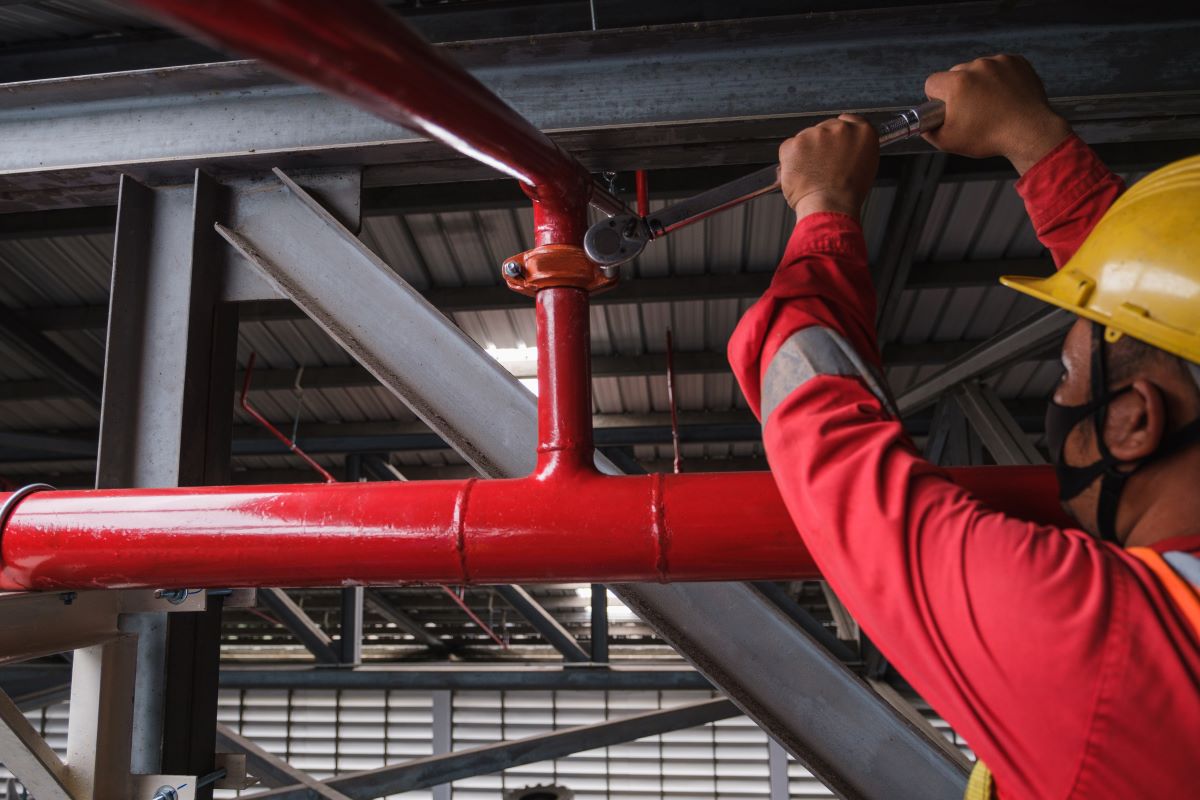A dry pipe system is a fire suppression method utilizing pressurized air in the pipes. The system releases water upon detecting heat from a fire.
Fire protection systems are essential in safeguarding buildings and occupants from fire hazards. Among these systems, the dry pipe system stands out for its unique operation suited for environments prone to freezing, like unheated buildings or parking garages. This system maintains air pressure within its piping until a fire triggers the sprinkler heads, causing the valve to release and water to flow through the pipes to extinguish the fire.
It offers a reliable solution for situations where standard wet pipe systems could fail due to frozen pipes. Embracing a design that provides safety even in cold conditions, dry pipe systems are a critical fire protection strategy for specific applications.
Basics Of Dry Pipe Fire Sprinkler Systems

Dry pipe fire sprinkler systems provide strong protection against fires in places where temperatures may freeze. Unlike traditional wet systems, these special systems use pressurized air or nitrogen in the pipes. Water only rushes in when needed. This design is perfect for unheated buildings or outdoor spaces.
Key Components
The anatomy of a dry pipe system is unique. It consists of several key parts:
- Main Control Valve: This valve separates air from the water supply.
- Pipes: They carry pressurized air and water during activation.
- Automatic Sprinklers: These open up when detecting high temperatures.
- Air Compressor: This fills the pipes with air under pressure.
How It Works
Dry pipe systems activate in two steps:
- Sprinklers detect heat and open.
- Air escapes, valve releases, water flows.
Air pressure in the pipes is key. When a fire happens, the air gets out and the water comes in. It’s a simple swap that saves property and lives. Sprinklers spray water directly on the fire. Quick action matters. That’s why these systems are smart choices for cold places or areas with valuable items that must stay dry.
Comparing Wet And Dry Pipe Systems
Fire protection matters to everyone, whether you own a building or work in one. Two common systems stand out: wet and dry pipe systems. Both serve the same purpose, but their differences dictate where they perform best. In this section, we’ll compare these systems and explore their ideal scenarios.
Operational Differences
Wet pipe systems are simple. They always have water in the pipes, ready to go. When a fire triggers the system, water sprays immediately.
Dry pipe systems are a bit different. The pipes stay dry until needed. When a fire is detected, the system fills up with water and then sprays the area.
| Feature | Wet Pipe System | Dry Pipe System |
|---|---|---|
| Speed of Activation | Immediate | Delayed |
| Risk of Freezing | Low | None |
| Complexity of Design | Simple | More complex |
| Maintenance | Easier | Requires special attention |
Ideal Use Cases
Each system shines under certain conditions.
- Wet pipe systems thrive in places that never freeze, like homes, offices, and schools.
- Dry pipe systems excel in cold spaces that can freeze, such as unheated warehouses or parking garages.
The list below further clarifies their best environments:
- Wet pipe for quick response in regularly occupied buildings.
- Dry pipe for areas with temperature variations or outdoors.
Importance Of Dry Pipe Systems In Building Safety
The importance of dry pipe systems in building safety cannot be overstated. Unlike traditional wet pipe sprinkler systems, which can be problematic in environments subject to freezing temperatures or where accidental water discharge could be disastrous, dry pipe systems provide a robust solution. By ensuring reliable fire protection without the risk of water damage in specific settings, these systems are critical to the integrity and safety of buildings.
Fire Protection In Cold Climates
Buildings in regions where temperatures routinely drop below freezing face unique challenges. Water in the pipes can freeze, causing damage or system failure. This is where dry pipe systems shine.
- They keep the pipes filled with pressurized air.
- Water only flows when fire is detected.
- The system prevents freezing and pipe bursts.
Applications In Sensitive Environments
Sensitive environments, such as data centers or museums, need fire protection without water damage risk. Dry pipe systems offer this specialized solution.
| Environment | Reason for Dry Pipe System |
|---|---|
| Archives | Protects historical documents |
| Data Centers | Safeguards electronic equipment |
| Art Galleries | Preserves valuable artwork |

Credit: marmicfire.com
Installation Guidelines
Dry pipe systems safeguard buildings against fire by keeping pipes filled with air. This air holds water back via a control valve. To ensure these systems work properly, correct installation is crucial. We will explore the key steps and compliance standards necessary for setting up a dry pipe system.
Professional Installation
Only qualified professionals should install dry pipe systems. This ensures the system’s reliability and effectiveness. Here’s a quick rundown on professional installation:
- Choose certified technicians experienced with dry pipe systems.
- Technicians will map out your space, planning pipe routes for optimal coverage.
- The system requires precise angle and support calculations for stability.
- Professionals will rigorously test the system for air and water-tightness.
Compliance With Safety Standards
Installation must comply with regional safety standards. This ensures the system meets legal and safety requirements.
| Standard | Description | Importance |
|---|---|---|
| NFPA 13 | Guidelines for System Design and Installation | Essential for system efficacy and safety |
| Local Codes | Vary by location; address specific needs | Legal compliance and context relevance |
Installers must ensure:
- Understanding and adherence to all applicable codes
- Correct pipe sizing for efficient operation
- Regular maintenance post-installation for system integrity
Maintenance Best Practices
Maintenance Best Practices are crucial for the longevity and reliability of a Dry Pipe System. These practices help to prevent failures and ensure the system operates as intended during emergencies. The following measures are essential for optimal performance:
Regular Inspections
To safeguard the functionality of a Dry Pipe System, consistent checks are imperative. Inspections involve:
- Visual examination of pipes for signs of rust or damage.
- Checking control valves to confirm they are accessible and properly sealed.
- Ensuring the air pressure levels meet the recommended settings.
- Examining sprinkler heads for obstructions or debris.
Record your findings in a maintenance log. This log aids in tracking the system’s condition over time.
System Testing And Upkeep
Testing and maintenance complement regular inspections and involve:
- Conducting full system trip tests annually to verify operations.
- Cleaning and servicing all system components as necessary.
- Replacing worn or damaged parts promptly to maintain system integrity.
- Updating the system with the latest safety features and technologies.
For detailed records and optimal results, engage qualified professionals for system testing and upkeep.
Troubleshooting Common Issues
The Dry Pipe Fire Sprinkler System stands as a reliable guardian against fires in spaces where temperatures may dip below freezing. Yet, even the mightiest systems encounter issues now and then. Learning to troubleshoot common issues keeps your fire protection system in top-notch condition and your property safe.
Dealing With False Alarms
False alarms can be more than just a nuisance; they indicate potential system sensitivity that needs addressing. Here’s what to do:
- Periodically Inspect Valves: Ensure they are set correctly and have not been tampered with.
- Regular Maintenance: Implement consistent checks to identify any signs of wear and tear.
- Update Air Pressure Settings: Sometimes adjusting the air pressure helps prevent false triggering of the system.
Preventing Pipe Freezing
Freezing conditions can halt a dry pipe system’s effectiveness. Follow these tips to prevent ice blockages:
- Environmental Controls: Keep ambient temperatures above freezing in areas with dry pipe systems.
- Insulation: Wrap pipes to protect them from the cold.
- Drainage: Remove residual water from low points in the piping to prevent ice formation.
Advancements In Dry Pipe System Technologies
Fire sprinkler systems are essential in protecting buildings from fire. Dry pipe systems offer unique advantages where water can’t always be in the pipes. New technologies make these systems more reliable and easier to manage. Let’s dive into the latest advancements.
Innovations In Design
New materials and improved pipe layouts have enhanced the effectiveness of dry pipe systems. These advancements include:
- Lighter, corrosion-resistant materials which extend the life of the system.
- Flexible piping options to fit complex building designs.
- Optimized air pressure control to prevent false activations.
| Feature | Benefit |
|---|---|
| Corrosion-resistant pipes | Longer system lifespan |
| Flexible piping design | Easy installation in complex structures |
| Enhanced air pressure mechanisms | Minimized false alarms |
Smart Monitoring Solutions
Cutting-edge smart technology is reshaping how we monitor dry pipe systems. Features include:
- Real-time alerts for potential issues before they escalate.
- Automated system health checks to ensure readiness.
- Integrated software for remote management and diagnostics.
These smart systems reduce maintenance costs and improve response times during emergencies.
Case Studies: Successful Deployments
Fire safety is crucial for every building. We always want the best protection for our places. Dry pipe systems have shown their worth across various settings. Let’s explore some real successes that prove their value.
Industrial Facilities
Industrial settings often face high fire risks due to flammable materials. Here’s how dry pipe systems made a big difference:
- Chemical Plant in Texas: A fire broke out in a storage area. The dry pipe system activated promptly. It controlled the blaze until the firefighters arrived. Damage was minimal.
- Electronics Factory: Sensitive equipment needed protection from water damage. The factory installed a dry pipe system. It safeguarded the equipment during a fire, without any water-related damages.
Historic Building Preservation
Old buildings have unique challenges. They need fire protection that doesn’t harm historic features. Here are cases where dry pipe systems protected heritage:
- Victorian Museum in London: Here, traditional wet systems could cause damage. They chose a dry pipe system. It’s hidden and safe for the vintage interior. There was a small fire once, and the system worked flawlessly.
- Ancient Library: Books and manuscripts are very fragile. The library installed a dry pipe system so water would not leak on these treasures. When a fire started in a reading room, the system was a success. It saved centuries-old texts from fire and water damage.
Future Of Fire Protection
The realm of fire safety is rapidly evolving. Dry pipe systems, known for their use in freezing environments, are capitalizing on technological advancements. This progression paves the way for smarter and safer buildings. As we look forward, expect dynamic changes. These innovations aim to save lives and protect property more efficiently.
Emerging Trends
Technological advancements reshape fire protection. New trends enter the market, promising enhanced efficiency and effectiveness. Let’s explore these cutting-edge developments:
- Smart Sprinkler Systems: Self-diagnosing sprinklers predict maintenance needs.
- Eco-friendly Agents: Less harmful to the environment, these agents are becoming standard.
- Sound Wave Fire Extinguishers: They use sound waves to extinguish fires without water damage.
Integrating With Building Automation
Building automation systems (BAS) are revolutionizing how facilities manage fire safety. The integration of dry pipe systems with BAS ensures:
| Integration Aspect | Benefits |
|---|---|
| Real-Time Monitoring | Quick response to incidents, preventing major damage. |
| Predictive Maintenance | Avoids system failures through timely alerts. |
| Energy Efficiency | Decreases water and power usage, lowering costs. |
These integrations signify a move towards intelligent fire protection. Systems communicate to create a cohesive defense against fire risks. This ensures higher safety standards and a future where fire protection is more reliable than ever.

Frequently Asked Questions Of Dry Pipe System
What Is A Dry System Pipe?
A dry system pipe is a fire protection mechanism with air-filled pipes, designed for spaces at risk of freezing. Water enters upon system activation, providing fire suppression without the risk of pipe bursts due to ice.
What Is The Major Advantage Of Dry Pipe System?
The major advantage of a dry pipe fire sprinkler system is its effectiveness in environments prone to freezing, as water is not stored within the pipes until needed.
What Is The Difference Between A Wet Pipe And A Dry Pipe System?
A wet pipe system contains water inside the pipes constantly, ready for immediate discharge, whereas a dry pipe system holds pressurized air or nitrogen, releasing water once the pressure drops after a fire triggers the system.
What Are The Disadvantages Of A Dry Pipe Sprinkler System?
Dry pipe sprinkler systems face several disadvantages, including delayed water delivery due to air needing to vent first, higher installation and maintenance costs, and potential for pipe freezing in colder climates. They also require more complex components and design considerations.
Conclusion
Summarizing, dry pipe systems offer robust protection for locations prone to freezing. Their delayed water delivery works well in specific environments, safeguarding property with minimal damage. Remember to consult professionals for installation and maintenance. Protect your assets effectively with a well-chosen dry pipe fire suppression system.

I’m Abdus Sobur, a highly skilled and professional Fire Safety Officer with a passion for safeguarding lives and property. Over the course of my career, I’ve conducted numerous successful fire safety audits, earning a reputation for excellence in ensuring public safety.
In addition to my role as a Fire Safety Officer, I’m also dedicated to raising awareness about the importance of fire safety. Through my blog, I share insights into the functions of different fire safety equipment, aiming to empower individuals with the knowledge they need to protect themselves and their communities.
I’m driven by a deep commitment to promoting fire safety awareness and preventing fire-related incidents.

